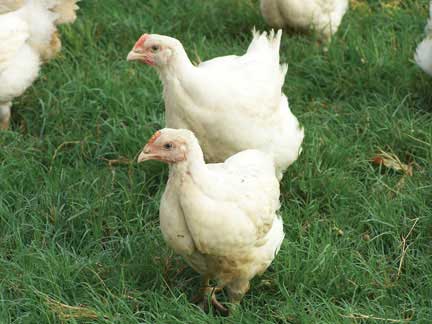November
2005
The Lucky
Few
By Miyun Park |
 |
Bulldozer full of dead
chickens. |
 |
Chickens recovering at Black Beauty Ranch.
Photos courtesy of HSUS |
Millions of animals were killed by
Hurricane Katrina. Because Katrina barreled through one of our nation’s
top chicken raising areas, most of the animals affected were birds,
left to drown
or starve.
Animals confined on factory farms are particularly vulnerable. For example, on
most egg farms, if the power goes out or the water is no longer available, hundreds
of thousands of animals can smother to death within days, due to the stifling
summer heat and toxic ammonia. Factory farmed animals are typically in a state
of life-long suffering because of their poor living conditions, and a disaster
like this only makes the situation worse. As a result, most factory farmed pigs
and chickens, oftentimes locked in crates or cages, can only stand helpless and
terrified as the floodwaters rise. That is not how their deaths are reported,
though.
In the world of industrialized animal agriculture, the suffering of millions
is callously reduced to what they call “lost production.” One poultry
processor, for example, “lost 8.2 million head of chickens in Katrina.” “Chicken
lovers,” one Mississippi paper reported with a sigh of relief, “don’t
have to be afraid of a rise in the price of poultry in the aftermath of Hurricane
Katrina.”
A typical press report reads: “According to the American Farm Bureau Federation,
farmers in southwestern Louisiana were hurt most by Hurricane Rita, which has
resulted in the loss of 30,000 cattle and seriously harmed rice fields and the
harvest of sugar cane.” The farmers were hurt, but the cattle were merely “lost.” Serious
harm was reserved for the rice fields.
Raising cattle in vulnerable coastal areas resulted in thousands of animals,
suffering from rotting hooves and open sores, eventually giving in and drowning
after the days-long fight to keep their heads above the filthy water.
This is not the first time a disaster of this kind has disproportionately taken
the lives of those who mean so little. In 1999, when Hurricane Floyd hit North
Carolina, floodwaters washed out pig factory farm manure lagoons, choking coastal
rivers with waste and tens of thousands of rotting hog carcasses. The waste reportedly
created a 350 square-mile dead zone in our nation’s second largest estuary,
killing millions of aquatic animals as well.
But, this time, all were not abandoned. Rescuers from the Humane Society of the
United States, Farm Sanctuary and Animal Place raced to Mississippi to rescue
animals trapped in filthy pens, stalls, cages, and sheds without food or water.
We were met with many dead ends and even more dead animals. Driving down rural
highways we could smell the smothered chickens, rotting in the heat long before
the football field sized sheds came into view.
Many of the farms in the state are owned by “contract growers,” which
means that the birds are owned by the larger company which contracts the animals
(and much of the financial risk) to the grower. As a result, most of the farmers
told us they could not allow our team to rescue birds who didn’t belong
to them.
After driving for days, we finally found a farm that would let us clean up their
mess. The farm had five massive sheds, one of which had been totally demolished
in the storm, with two others damaged. Dead chickens were everywhere. The farm
workers had captured around 15,000 birds who had survived the damage, stuffing
as many as they could fit into the remaining sheds. The rest were left outside
to die. The farmer told the team that we were welcome to any birds who still
survived.
Our team returned at night, when chickens are calmer and easier to catch. Some
of the birds were so still that we thought they were dead, but with a gentle
touch they would slowly open their eyes. We rescued 300 chickens that first night.
The next day, we learned of another damaged facility in the area. Someone had
called Tyson to complain about the smell. There were so many dead chickens that
the caller said it looked like a “field of cotton.” She was willing
to let the response team onto her property but, by the time we reached the farm,
Tyson’s crew was already on site, bulldozing the remaining sheds and whatever
chickens were alive inside.
It was nighttime by then and, devastated and exhausted, we had arrived hours
too late. We thought we’d make one last stop at the first farm to see if
we could get any more birds. We thought maybe we’d get a dozen, we ended
up rescuing over 700 more.
These birds had escaped from the sheds and the cleanup crews and made their way
into the surrounding woods. They huddled together quietly in small groups looking
to each other for comfort. We circled in on them and gently lifted them into
our vehicle.
During one of our final searches, we came upon a deep pit full of empty beer
cans and dead chickens. Steam from the decomposition rose from the maggot-ridden
pit. Then we saw movement. Scanning with our headlamps, we could see live chickens
desperate to escape the mass grave. Using a long pole and a net, we were able
to scoop them out of the pit to safety.
All of these birds are now safe in sanctuaries across the country, with most
now living at Farm Sanctuary. After round-the-clock administration of IV fluids,
antibiotics, pain medications, heating pads, and TLC, the birds are now strong
and healthy. They will live out their full natural lives with sun instead of
darkness, fresh air instead of choking ammonia, and grass instead of ankle-deep
feces. For these lucky chickens, the hurricane saved their lives.
Miyun Park is the Director of Farm Animal Welfare at the Humane Society of the
United States and the former President of Compassion Over Killing. To learn more,
visit www.hsus.org.


